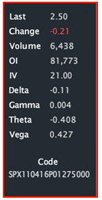The option Greek Theta, which measures time decay, can throw traders a difficult curve as expiration day approaches. Learn to respond accordingly in order to avoid two critical, costly mistakes.
One of the most common mistakes my option mentoring students make is to misunderstand Theta.
This usually comes to surface in the final few of weeks leading into expiration. However, I do not blame those students at first. After all, they have a good excuse. The option pricing models often don’t accurately reflect the actual affect of Theta. That's right; the pricing model is almost always wrong in final few weeks of trading!
First, a quick explanation of the option Greek Theta:
Theta, (a.k.a. “time decay”), is an estimate of how much the theoretical value of an option decreases when one day passes and there is no move in either the stock price or volatility.
Theta is used to estimate how much an option's extrinsic value is whittled away by the always-constant passage of time.
The Theta for a call and put at the same strike price and the same expiration month are not equal. Without going into detail, the difference in Theta between calls and puts depends on the cost of carry for the underlying stock.
When the cost of carry for the stock is positive (i.e. dividend yield is less than the interest rate), Theta for the call is higher than the put. When the cost of carry for the stock is negative (i.e. dividend yield is greater than the interest rate), Theta for the call is lower than the put.
Long calls and long puts always have negative Theta. Short calls and short puts always have positive Theta. Stock has zero Theta because its value is not eroded by time.
All other things being equal, an option with more days to expiration will have more extrinsic value than an option with fewer days to expiration. The difference between the extrinsic value of the option with more days to expiration and the option with fewer days to expiration is due to Theta. Therefore, it makes sense that long options have negative Theta and short options have positive Theta.
If options are continuously losing their extrinsic value, a long option position will lose money because of Theta, while a short option position will make money because of Theta.
But Theta doesn't reduce an option's value in an even rate. Theta has much more impact on an option with fewer days to expiration than an option with more days to expiration.
Most commonly, it overestimates the decay in cheap options, especially puts. This causes traders to make two major mistakes:
- They hold cheap options for too long
"Well my Theta said that I was still collecting a lot of premium." This is the classic line I hear from green students when I chastise them for leaving open a position that could potentially blow them up. The “fake” Theta number is a major culprit behind blown-up open positions, especially in the income trading world.
- They do not insure their positions properly
Fake or inaccurate Theta leads traders to think that they are buying options that are “killing” Theta when most likely, the insurance is doing nothing. It can cause traders to buy true garbage options, rather than insurance that can save a position.
Here is a great earlier example of fake Theta. Below is the breakdown for the April 1275 puts:
Right now, the1275 puts are worth about $2.50, and have a Theta of .41 a day. At that rate of Theta, the puts would be completely worthless with about four days until expiration. This also happens to be the exact amount of time the current weekly SPX 1275 options have until they expire. Thus, based on the Theta of regular 1275's, our weekly SPX 1275 puts should be completely worthless.
Here is the closing quote:
As you can see, at a price of near .70, this option in not worthless. Why? Quite simply, the model gets it wrong when options start to expire.
Many retail options traders do not need to simply understand the Greeks that the model produces; they also need to understand the model's limitations. One of those limitations is that Theta decay stops being accurate as an option’s life ends.
One way the model tries to make up for this is by increasing implied volatility of the option. This is why you may notice that as we get close to expiration, cheap calls and puts have an implied volatility that slowly rises. Here is the current path of implied volatility of the regular April 1275 puts:
Notice that implied volatility (IV) is starting to creep up. As the week passes, the IV will creep higher as the model tries to make up for the options not decaying properly.
Here is a challenge: Pick out a stock or index and write down the closing price and Theta of that option. Note when it will, according to the model, become worthless. Then monitor that option to see when it actually becomes worthless. It will be an eye-opening lesson.
By Marc Sebastian of OptionPit.com




















